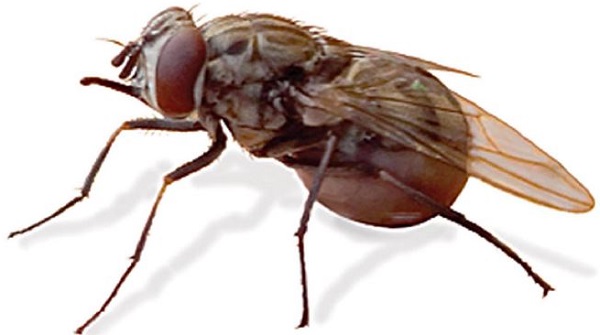Molecular detection of <em>Anaplasma marginale</em> in stable flies <em>Stomoxys calcitrans</em> (Diptera: Muscidae) feeding on a tick-free bovine herd
Main Article Content
Abstract
Veterinaria México OA
ISSN: 2448-6760
Cite this as:
- Bautista-Garfias CR, Rodríguez T, Rojas C, Lira JJ, Álvarez JA, Polanco D. Molecular detection of Anaplasma marginale in stable flies Stomoxys calcitrans (Diptera: Muscidae) feeding on a tick-free bovine herd. Veterinaria México OA. 2018;5(1). doi: 10.21753/vmoa.5.1.436.
Data on the implication of the stable fly (Stomoxys calcitrans, Diptera: Muscidae), in the transmission of Anaplasma marginale in tick-free cattle is scarce. Hence, the objective of this investigation was to detect the presence of DNA from A. marginale in stable flies caught near a bovine herd, which has been maintained free of ticks for 40 years, and occasionally presents some clinical cases of anaplasmosis. Twenty-four batches of S. calcitrans (15 flies each) were collected in the morning and in the afternoon twice a week (except for one catch in one week of September and one catch in one week of December) during 12 catching days in a period of four months. Their DNA was obtained and analysed by nested PCR (nPCR) to identify the presence of A. marginale DNA. Seven of the batches (29.16 %) were positive for A. marginale, as detected by an nPCR that targets the A. marginale msp5 gene. Similarly, in two out of 12 catching days (16.66 %), those S. calcitrans batches collected in the morning and in the afternoon, were positive for A. marginale, while those S. calcitrans groups collected in three out of 12 catching days (25 %), were positive for the rickettsia. The obtained results suggest that A. marginale transmission is carried out mechanically by S. calcitrans, favouring the circulation and maintenance of the microorganism in this particular bovine herd.
Article Details
References
Ewing SA. Transmission of Anaplasma marginale by arthropods. In: Hidalgo and Jones WE [eds.]. Proceedings of the seventh national anaplasmosis conference, Starkville, MS. Mississippi State University, Mississippi State. 1981; pp.425-434.
Potgieter FT, Sutherland B, Biggs HC. Attempts to transmit Anaplasma margin¬ale with Hippobosca rufipes and Stomoxys calcitrans. Onderstepoort J Vet Res. 1981; 48:119-122.
Hawkins J.A, Love JN, Hidalgo RJ. Mechanical transmission of anaplasmosis by tabanids (Diptera:Tabanidae). Am J Vet Res. 1982; 43:732-734.
Lew-Tabor AE, Rodriguez Valle M. A review of reverse vaccinology approaches for the development of vaccines against ticks and tick borne diseases. Ticks Tick Borne Dis. 2016;7: 573–585.
French DM, McElwain TF, McGuire TC, Palmer GH. Expression of Anaplasma marginale major surface protein 2 variants during persistent cyclic rickettsemia. Infect Immun. 1998; 66: 200-1207.
Scoles GA, Broce AB, Lysyk TJ, Palmer GH. Relative efficiency of biological trans¬mission of Anaplasma marginale (Rickettsiales: Anaplasmataceae) by Derma¬centor andersoni (Acari:Ixodidae) compared with mechanical transmission by Stomoxys calcitrans (Diptera: Muscidae). J Med Entomol. 2005; 42: 668-675.
Machado ZR, Barbosa da Silva J, André MR, Goncalves RL, Matos CA, Obregón D. Outbreak of anaplasmosis associated with the presence of different Anaplas¬ma marginale strains in dairy cattle in the states of Sao Paulo and Goias, Brazil. Braz J Vet Parasitol Jaboticabal. 2015; 24:438-446.
Oliveira JB, Montoya J, Romero JJ, Urbina A, Soto-Barrientos N, Melo ESP et al. Epidemiology of bovine anaplasmosis in dairy herds from Costa Rica. Vet. Parasitol. 2011;177:359-365.
Weber AF, Moon RD, Sorensen DK, Bates DW, Meiske JC, Brown CA, et al. Evaluation of the stable fly (Stomoxys calcitrans) as a vector of enzootic bovine leukosis. Am J Vet Res. 1988; 49:1543-1549.
Kloft WJ. Radioisotopes in vector research, pp. 41-66. In K. F. Harris [ed.], Ad¬vances in disease vector research. Springer, New York.1992.
Coronado, A. ¿Es Boophilus microplus el principal vector de Anaplasma mar¬ginale? Rev Cient FC-LUZ. 2001; 11:408-411.
Baldacchino F, Muenworn V, Desquesnes M, Desoli F, Charoenviriyaphap T, Du¬vallet G. Transmission of pathogens by Stomoxys flies (Diptera, Muscidae): a review. Parasite. 2013;20:26.doi:10.1051/parasite/2013026.
Bautista Garfias CR. Entomología veterinaria esencial. Segunda edición. 2016. CENID-PAVET, INIFAP, Jiutepec, Morelos, México.
Torioni S, Knowles DP, McGuire TC, Palmer GH, Suarez CE, McElwain TF. Detec¬tion of cattle naturally infected with Anaplasma marginale in a region of ende¬micity by nested PCR and a competitive Enzyme-Linked Immunosorbent Assay using recombinant major surface protein 5. J Clin Microbiol.1998; 36:777-782.
Rodríguez SD, García Ortiz MA, Jiménez Ocampo R, Vega y Murguía CA. Molec¬ular epidemiology of bovine anaplasmosis with particular focus in Mexico. Infect Gen Evol.2009; 9:1092-1101.
Guillemi EC, de la Fourniere S, Orozco M, Peña Martínez, J, Correa E., Fernández J. et al. Molecular identification of Anaplasma marginale in two autochthonous south American wild species revealed an identical new genotype and its phylo¬genetic relationship with those of bovines. Parasites & Vectors.2016; 9:305 DOI 10.11186/s13071-016-1555-9.
Zumpt F. The Stomoxyine biting flies of the world. Gustav Fischer Verlag. Stutt¬gart.1973; pp. 137-152.
Pitzer JB, Kaufman PE, Tenbroeck SH, Maruniak JE. Host blood meal identifi¬cation by multiplex polymerase chain reaction for dispersal evidence of sta¬ble flies (Diptera:Muscidae) between livestock facilities. J Med Entomol. 2011; 48:53-60.
Kocan KM, de la Fuente J, Guglielmone AA, Meléndez RD. Antigens and alter¬natives for control Anaplasma marginale infection in cattle. Clin Microbiol Revs. 2003;16:698-712.
License

Veterinaria México OA by Facultad de Medicina Veterinaria y Zootecnia - Universidad Nacional Autónoma de México is licensed under a Creative Commons Attribution 4.0 International Licence.
Based on a work at http://www.revistas.unam.mx
- All articles in Veterinaria México OA re published under the Creative Commons Attribution 4.0 Unported (CC-BY 4.0). With this license, authors retain copyright but allow any user to share, copy, distribute, transmit, adapt and make commercial use of the work, without needing to provide additional permission as long as appropriate attribution is made to the original author or source.
- By using this license, all Veterinaria México OAarticles meet or exceed all funder and institutional requirements for being considered Open Access.
- Authors cannot use copyrighted material within their article unless that material has also been made available under a similarly liberal license.




